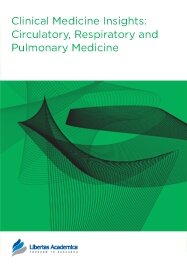

Publication Date: 01 Feb 2008
Journal: Clinical Medicine Insights: Circulatory, Respiratory and Pulmonary Medicine
Citation: Clinical Medicine: Circulatory, Respiratory and Pulmonary Medicine 2008:2 1-9

Background: The respiratory exchange ratio (RER) indirectly shows the muscle´s oxidative capacity to get energy. Sedentarism, exercise and physically active lifestyles modify it. For that reason, this study evaluates the associations between RER during sub-maximum exercise and other well established fitness indicators (body fat, maximum heart rate, maximum O2 uptake, workload, and lactate threshold), in physically active trained and untrained men.
Methods: The RER, O2 uptake and blood lactate were measured in eight endurance trained and eight untrained men (age, 22.9 ± 4.5 vs. 21.9 ± 2.8 years; body mass, 67.1 ± 5.4 vs. 72.2 ± 7.7 kg; body fat, 10.6 ± 2.4% vs. 16.6 ± 3.8% and maximum O2 uptake, 68.9 ± 6.3 vs. 51.6 ± 5.8 ml•kg−1•min−1), during maximum exercise test and during three different sub-maximum exercises at fixed workload: below, within or above the lactate threshold.
Results: Endurance trained men presented higher O2 uptake, lower blood lactate concentrations and lower RER values than those in untrained men at the three similar relative workloads. Even though with these differences in RER, a strong association (p < 0.05) of RER during sub-maximum exercise with the other well established fitness indicators was observed, and both maximum O2 uptake and lactate threshold determined more than 57% of its variance (p < 0.05).
Conclusions: These data demonstrate that RER measurement under sub-maximum exercise conditions was well correlated with other established physical fitness indicators, despite training condition. Furthermore, the results suggest that RER could help obtain an easy approach of fitness status under low exercise intensity and could be utilized in subjects with reduced exercise tolerance.
PDF (595.99 KB PDF FORMAT)
RIS citation (ENDNOTE, REFERENCE MANAGER, PROCITE, REFWORKS)
BibTex citation (BIBDESK, LATEX)
XML
PMC HTML

The experience of publishing with Clinical Medicine Insights: Ear, Nose and Throat was amazing. The prompt review and author friendly system made the process very simple and fast. The best part was the meticulous guidance provided by the editor in every step of the publication. I am very happy to be associated with such a dedicated and thoroughly professional team. I would certainly recommend others to submit their works to this journal and experience the ...
Facebook Google+ Twitter
Pinterest Tumblr YouTube